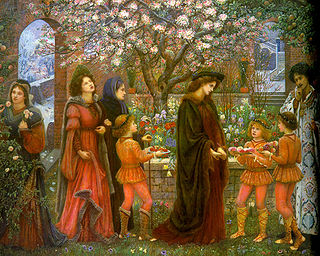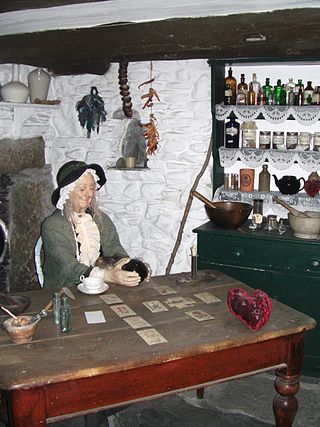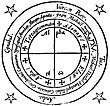
In Christian belief, a saint is a person who is recognized as having an exceptional degree of holiness, likeness, or closeness to God. However, the use of the term saint depends on the context and denomination. In Catholic, Eastern Orthodox, Anglican, Oriental Orthodox, and Lutheran doctrine, all of their faithful deceased in Heaven are considered to be saints, but some are considered worthy of greater honor or emulation. Official ecclesiastical recognition, and consequently a public cult of veneration, is conferred on some denominational saints through the process of canonization in the Catholic Church or glorification in the Eastern Orthodox Church after their approval.

Magic is an ancient practice rooted in rituals, spiritual divinations, and/or cultural lineage—with an intention to invoke, manipulate, or otherwise manifest supernatural forces, beings, or entities in the natural world. It is a categorical yet often ambiguous term which has been used to refer to a wide variety of beliefs and practices, frequently considered separate from both religion and science.
Theurgy, also known as divine magic, is one of two major branches of the magical arts, the other being practical magic or thaumaturgy. Theurgy describes the ritual practices associated with the invocation or evocation of the presence of one or more deities, especially with the goal of achieving henosis and perfecting oneself.

An incantation, a spell, a charm, an enchantment, or a bewitchery, is a magical formula intended to trigger a magical effect on a person or objects. The formula can be spoken, sung, or chanted. An incantation can also be performed during ceremonial rituals or prayers. In the world of magic, wizards, witches, and fairies are common performers of incantations in culture and folklore.

Magic words are phrases used in fantasy fiction or by stage magicians. Frequently such words are presented as being part of a divine, adamic, or other secret or empowered language. Certain comic book heroes use magic words to activate their powers. Magic words are also used as Easter eggs or cheats in computer games, other software, and operating systems.
The bard is a standard playable character class in many editions of the Dungeons & Dragons fantasy role-playing game. The bard class is versatile, capable of combat and of magic. Bards use their artistic talents to induce magical effects. The class is loosely based on the special magic that music holds in stories such as the Pied Piper of Hamelin, and in earlier versions was much more akin to being a Celtic Fili or a Norse Skald, although these elements have largely been removed in later editions. Listed inspirations for bards include Taliesin, Homer, Will Scarlet and Alan-a-Dale.
The cleric is one of the standard playable character class in the Dungeons & Dragons fantasy role-playing game. Clerics are versatile figures, both capable in combat and skilled in the use of divine magic (thaumaturgy). Clerics are powerful healers due to the large number of healing and curative magics available to them. With divinely-granted abilities over life or death, they are also able to repel or control undead creatures. Clerics also have specific 'domains' which usually align with the character's alignment and the god that cleric serves. Whether the cleric repels or controls undead is dependent on the cleric's alignment. It is the only class to be included in every edition of Dungeons & Dragons without a name change.

The royal touch was a form of laying on of hands, whereby French and English monarchs touched their subjects, regardless of social classes, with the intent to cure them of various diseases and conditions. The thaumaturgic touch was most commonly applied to people suffering from tuberculous cervical lymphadenitis, and exclusively to them from the 16th century onwards. The disease rarely resulted in death and often went into remission on its own, giving the impression that the monarch's touch cured it. The claimed power was most notably exercised by monarchs who sought to demonstrate the legitimacy of their reign and of their newly founded dynasties.
Godman is a colloquial unisex term used in India for a type of charismatic guru that is often raised to a demigod-like figure by their cult following. They usually have a high-profile presence, and are capable of attracting attention and support from large sections of the society. Godmen also sometimes claim to possess paranormal powers, such as the ability to heal, the ability to see or influence future events, and the ability to read minds.
A number of terms are used in Islam to refer to the claims of events happening that are not explicable by natural or scientific laws, subjects where people sometimes invoke the supernatural. In the Quran the term āyah refers to signs in the context of miracles of God's creation and of the prophets and messengers. In later Islamic sources miracles of the prophets were referred to by Muʿjiza (مُعْجِزَة), literally meaning "that by means of which [the Prophet] confounds, overwhelms, his opponents"), while miracles of saints are referred to as karamat (charismata). I'jaz al-Quran – literally the inimitability of the Quran – refers to the Quranic claim that no one can hope to imitate its perfection, this quality being considered the primary miracle of the Quran and proof of Muhammad's prophethood. In recent decades, the term I'jaz has also come to refer to the belief that the Quran contains "scientific miracles", i.e. prophecies of scientific discoveries. Kharq al'adad – "a break in God's customary order of things" – was a term used in "theological or philosophical discussions" to refer to miraculous events. Karamat – "gifts or graces" – was usually used for miraculous performances of Sufi saints often used to convert unbelievers to Islam.

Magic in the Greco-Roman world—that is, ancient Greece, ancient Rome, and the other cultures with which they interacted, especially ancient Egypt—comprises supernatural practices undertaken by individuals, often privately, that were not under the oversight of official priesthoods attached to the various state, community, and household cults and temples as a matter of public religion. Private magic was practiced throughout Greek and Roman cultures as well as among Jews and early Christians of the Roman Empire. Primary sources for the study of Greco-Roman magic include the Greek Magical Papyri, curse tablets, amulets, and literary texts such as Ovid's Fasti and Pliny the Elder's Natural History.

A magician, also known as an archimage, mage, magus, magic-user, spellcaster, enchanter/enchantress, sorcerer/sorceress, warlock, witch, or wizard, is someone who uses or practices magic derived from supernatural, occult, or arcane sources. Magicians enjoy a rich history in mythology, legends, fiction, and folklore, and are common figures in works of fantasy, such as fantasy literature and role-playing games.

Master of the Five Magics is a fantasy novel by Lyndon Hardy, first published in 1980. It is the first of a trilogy set in the same world; the second book is Secret of the Sixth Magic and the third Riddle of the Seven Realms. The books feature different characters, but each explores the same system of magic in successively more detail. It may be an early example of hard fantasy.

Witch, from the Old English wiċċe, is a term rooted in European folklore and superstition for a practitioner of witchcraft, magic or sorcery. Traditionally associated with malevolent magic, with those accused of witchcraft being the target of witch-hunts, in the modern era the term has taken on different meanings. In literature, a 'witch' can now simply refer to an alluring women capable of 'bewitching' others. In neopagan religions such as Wicca the term has meanwhile been adopted as the female term for an adherent.

An amulet, also known as a good luck charm or phylactery, is an object believed to confer protection upon its possessor. The word "amulet" comes from the Latin word amuletum, which Pliny's Natural History describes as "an object that protects a person from trouble". Anything can function as an amulet; items commonly so used include statues, coins, drawings, plant parts, animal parts, and written words.

Cunning folk, also known as folk healers or wise folk, were practitioners of folk medicine, helpful folk magic and divination in Europe from the Middle Ages until the 20th century. Their practices were known as the cunning craft. Their services also included thwarting witchcraft. Although some cunning folk were denounced as witches themselves, they made up a minority of those accused, and the common people generally made a distinction between the two. The name 'cunning folk' originally referred to folk-healers and magic-workers in Britain, but the name is now applied as an umbrella term for similar people in other parts of Europe.
Habib the Carpenter, or Habib Al-Najjar, was a martyr who lived in Antioch at the time of Jesus Christ. In Muslim tradition, Habib believed the message of Christ's disciples sent to the People of Ya-Sin, and was subsequently martyred for his faith. The Mosque of Habib-i Neccar, below Mount Silpium, contains the tomb of Habib along with that of Sham'un Al-Safa. Some sources have identified Habib with Saint Agabus of the Acts of the Apostles, an early Christian who suffered martyrdom in Antioch at the time of Jesus. This connection is disputed, as Christian tradition holds that Agabus was martyred at Jerusalem, and not at Antioch as Muslims believe of Habib. All Muslim sources list Habib's occupation as a carpenter.
The artificer is a playable character class in the Dungeons & Dragons (D&D) fantasy role-playing game. The Artificer first appeared as a full class in the 3.5 edition of D&D and was introduced in the Eberron campaign setting. The artificer is a unique base class that reflects many of the core themes of Eberron.
Superstition is an excessively credulous belief in supernatural causality: the belief that one event is the cause of another without any physical process linking the two, such as astrology, omens, witchcraft, and apotropaic magic. According to Rashid Shaz, belief in such supernatural causality is widespread in the Muslim world and predates the introduction of Islam. He argues they involve "clinging to false hope" and even shirk.
Belief and practice in Magic in Islam is "widespread and pervasive" and a "vital element of everyday life and practice", both historically and currently in Islamic culture. The topics also generating a "staggering" amount of literature.













